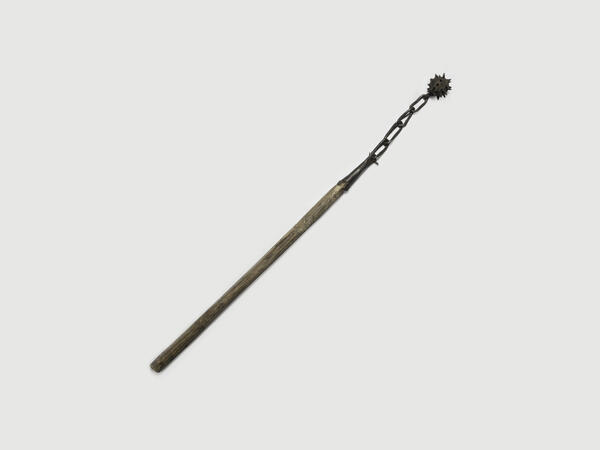The battle-flail is an ancient cold shock-crushing weapon. Externally, It is a short haft, at the end of which a metal ball is suspended on a belt, chain, or rope. The first battle flails appeared among the nomads in the 8th century. In Europe, the first information about this weapon dates back to the beginning of the 10th century. Knights in England, Germany, and Italy used kettlebells on a chain. In addition, Japanese samurai also had similar weapons. The name has Slavic roots: during the battle, the weapon was put on the wrist (in Russian the battle-flail is called ‘kisten’ and the wrist — ‘kist’ — hence, the name). Also, the word ‘kistan’ existed in the Turkic language and meant ‘stick’.
The weight, which was attached to the end of the stick, is called a ‘bilo’ (beater), while the haft is called ‘kistenishe’. The beater, as a rule, was made of metal, and the handle was wooden in most cases. The popularity of the weapon was explained by its simple design and cheapness. On the territory of Asia and Europe, such items were used in the period from the 10th to the 17th century.
Some researchers relate to battle-flails another similar type of weapon, which is distinguished by the absence of a haft — the slungshot. However, the difference in the technique of using these two tools was significant. The closest weapons to the battle flails were combat flails — they were so similar that it was quite difficult to clearly distinguish them. The main differences between combat flails and battle flails were considered to be a shorter belt, on which the beater was attached, as well as the longer length of the haft and the mass of the striking part.
In the Russian Empire, battle flails were used by a variety of social groups. Civilians used them for self-defense, robbers — for an attack, and rebels — as the main weapon during a riot. For example, battle flails were actively used during the uprising led by Pugachev in the 18th century. They became especially popular among coachmen, who carried battle flails with them as a tool of self-defense.
The museum collection includes a battle flail, which was the property of a coachman from Siberia. The length of the haft of the weapon was approximately 103 centimeters. On it, a cast-iron weight with spikes was suspended on a metal chain. The weight of the striking part was 800 grams. But some used kettlebells weighing up to one kilogram. With one blow of such a battle-flail, one could break a person’s skull, which immediately led to a fatal outcome.
Also, many people used battle-flails during hunting: they finished off wolves wounded or hunted by dogs. For this reason, non-professional excavation enthusiasts call battle-flails ‘wolfbats’. However, official science does not support such a term.
The weight, which was attached to the end of the stick, is called a ‘bilo’ (beater), while the haft is called ‘kistenishe’. The beater, as a rule, was made of metal, and the handle was wooden in most cases. The popularity of the weapon was explained by its simple design and cheapness. On the territory of Asia and Europe, such items were used in the period from the 10th to the 17th century.
Some researchers relate to battle-flails another similar type of weapon, which is distinguished by the absence of a haft — the slungshot. However, the difference in the technique of using these two tools was significant. The closest weapons to the battle flails were combat flails — they were so similar that it was quite difficult to clearly distinguish them. The main differences between combat flails and battle flails were considered to be a shorter belt, on which the beater was attached, as well as the longer length of the haft and the mass of the striking part.
In the Russian Empire, battle flails were used by a variety of social groups. Civilians used them for self-defense, robbers — for an attack, and rebels — as the main weapon during a riot. For example, battle flails were actively used during the uprising led by Pugachev in the 18th century. They became especially popular among coachmen, who carried battle flails with them as a tool of self-defense.
The museum collection includes a battle flail, which was the property of a coachman from Siberia. The length of the haft of the weapon was approximately 103 centimeters. On it, a cast-iron weight with spikes was suspended on a metal chain. The weight of the striking part was 800 grams. But some used kettlebells weighing up to one kilogram. With one blow of such a battle-flail, one could break a person’s skull, which immediately led to a fatal outcome.
Also, many people used battle-flails during hunting: they finished off wolves wounded or hunted by dogs. For this reason, non-professional excavation enthusiasts call battle-flails ‘wolfbats’. However, official science does not support such a term.



